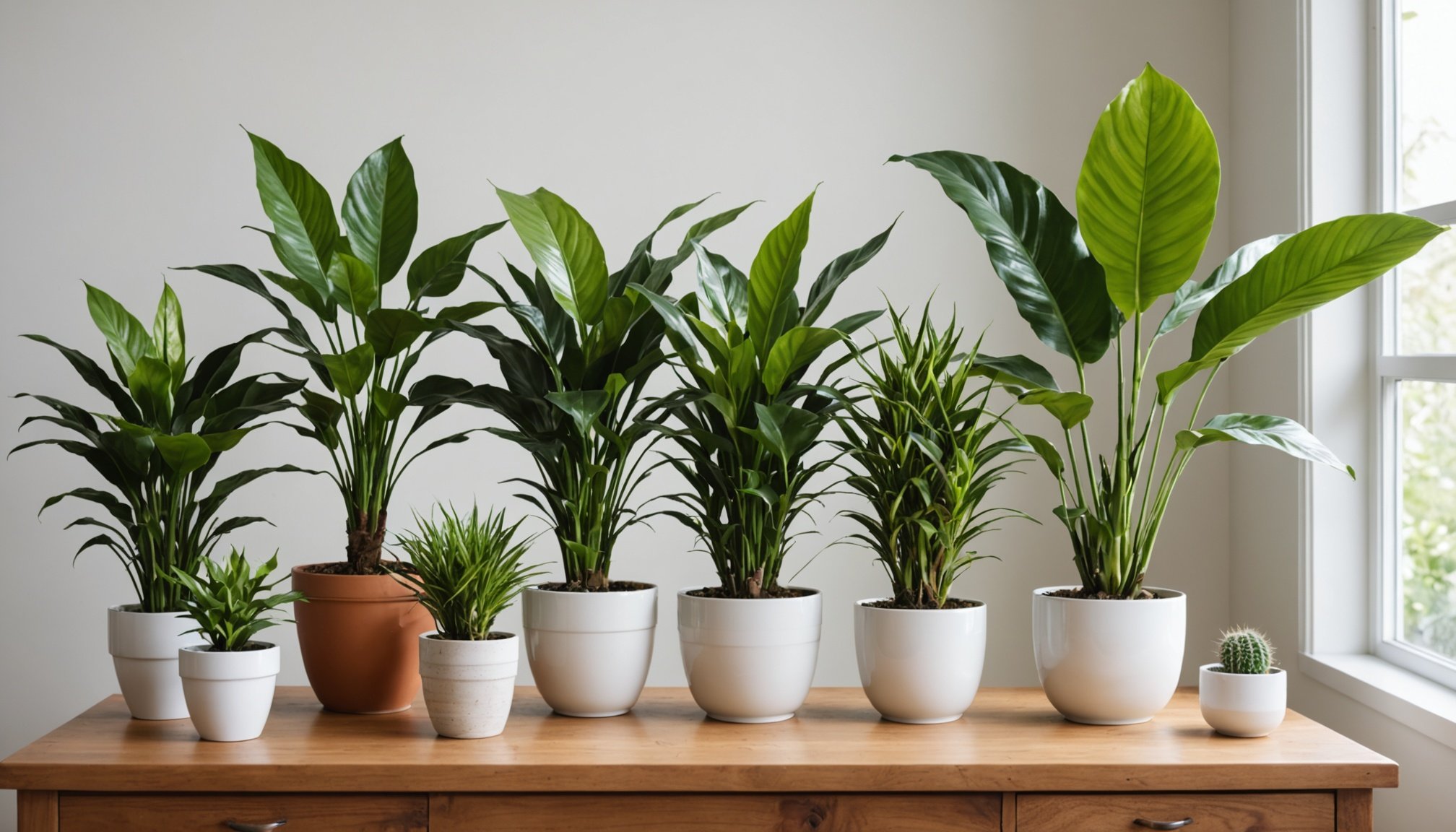Understanding Allergies and Indoor Plants
Common allergens indoors can vary from dust and pollen to pet dander and mold spores. These pollutants affect air quality and may exacerbate respiratory issues for allergy sufferers. Consequently, selecting the right indoor plants for allergies is crucial to mitigate these concerns. Certain plants not only enhance the aesthetic appeal but also aid in purifying indoor air, making them a valuable addition to your home.
Overview of Common Indoor Allergens
Airborne particles, such as dust mites and pet dander, are frequent indoor allergens. These can trigger symptoms like sneezing and respiratory distress. Mold spores also lurk in damp areas, complicating conditions for those with sensitivities.
Also to discover : The Ultimate Guide: Create a Thrilling and Secure Indoor Climbing Wall for Energetic Kids
Importance of Selecting the Right Plants
Incorporating allergy-friendly plants can significantly benefit individuals by reducing allergens. Plants like the spider plant and peace lily are known to filter out toxins and improve indoor air quality without releasing pollen or irritating odors.
Benefits of Having Plants Indoors
The presence of specific indoor plants for allergies enhances air quality by absorbing CO2 and releasing oxygen. This not only purifies the air but also creates a healthier living environment. Additionally, they add a natural element that can positively influence mental well-being, reducing stress and promoting tranquillity at home.
Have you seen this : Revamp Your Kitchen: Chic Ideas for Using Recycled Glass Countertops
Top Allergy-Friendly Indoor Plants
Choosing the best indoor plants for allergies can transform your living space into a healthier environment. These safe indoor plants are perfect for promoting well-being without triggering allergic reactions. Here’s a spotlight on some hypoallergenic plants that are both functional and stylish.
Peace Lily
The Peace Lily is a popular choice for allergy sufferers. It thrives in moderate to low light and needs watering about once a week. Its glossy leaves not only add beauty but also filter out air pollutants like benzene and formaldehyde. A note of caution: Keep it away from pets and children as it can be mildly toxic if ingested.
Spider Plant
Known for its resilience, the Spider Plant requires little maintenance. It thrives with indirect sunlight and regular watering. Its air-purifying properties are well-documented, effectively reducing airborne toxins. Position it in spaces where clean air is most desired, like living rooms or bedrooms.
Bamboo Palm
The Bamboo Palm is celebrated for its ability to remove indoor pollutants. It prefers bright, indirect light and consistent watering. Its lush foliage makes it ideal for corners of rooms, where it can efficiently improve air quality. Consider placing it in areas with adequate space to accommodate its broad leaves.
Caring for Allergy-Friendly Plants
Proper plant maintenance is crucial for keeping your allergy-friendly plants thriving. Ensuring they’re healthy enhances their ability to purify air. Here are essential insights into indoor plant care:
Regular watering tailored to each plant’s needs is fundamental. Overwatering can lead to root rot, while under-watering causes dehydration. Understand that different species require varying moisture levels. For example, the likes of the peace lily enjoy moist soil, whereas the spider plant prefers it to dry out slightly between waterings.
Lighting conditions are equally important. Many indoor plants thrive in indirect sunlight. Direct exposure can damage foliage, especially for low-light species like the bamboo palm. A suitable position will boost both plant health and air-quality benefits.
Choosing the correct soil type is vital for nutrient uptake. Well-draining soil is commonly recommended to prevent waterlogging and ensure root health. Consistently inspect the plant for signs of distress.
Finally, cleaning leaves helps reduce allergens in the home. Dust accumulation hinders photosynthesis and can increase indoor allergens. Gently wipe leaves with a damp cloth to keep your allergy-friendly plants vibrant and effectively purifying your home atmosphere. Regular upkeep creates a healthier, cleaner living space.
Plants to Avoid for Allergy Sufferers
While many plants are beneficial, some might act as allergy-inducing culprits hidden in plain sight. Recognizing harmful indoor plants is key for individuals prone to allergies. Certain plants produce pollen or are known for secretions that trigger allergic responses.
Typical Allergenic Plants
For instance, the popular weeping fig (Ficus benjamina) is notorious for causing respiratory distress in sensitive individuals. Its latex-like sap can provoke skin irritation. Furthermore, flowering plants such as lilies often release pollen, aggravating allergic reactions.
Symptoms to Watch For
Allergy symptoms typically include sneezing, itchy eyes, and skin irritation. In more severe cases, shortness of breath and wheezing might occur. A high level of precision and awareness is needed to ensure that environment adjustments cater to allergy sufferers effectively.
Safe Substitutions
To eliminate allergens without compromising green decor, offer hypoallergenic alternatives. Replace problematic species with allergy-friendly counterparts like the snake plant or boston fern, known for non-irritating attributes and air-purifying benefits. These options not only safeguard health but also maintain an appealing atmosphere.
Understanding your plant choices helps in crafting a home where indoor greenery amplifies health benefits rather than detracting from them, fostering a tranquil sanctuary devoid of pollen’s pesky presence.
The Best Placement for Indoor Plants
Finding the ideal placement for indoor plants involves more than just aesthetics. To effectively reduce allergens and maximize air purification, consider strategic locations. Placing indoor plants for allergies in areas with good air circulation enhances their ability to filter out pollutants. For instance, a bamboo palm in a well-ventilated living room can significantly decrease airborne toxins.
Balancing aesthetics and functionality is crucial in indoor plant arrangements. Positioning allergy-friendly plants in a manner that complements your home’s layout not only increases visual appeal but also supports respiratory health. Choose spots where plants receive the appropriate light, such as indirect sunlight for snake plants in bedrooms, to increase their air-cleaning efficacy.
Creating a serene atmosphere is achievable through thoughtful indoor plant placement. Arranging plants like peace lilies on windowsills or corners can add a soothing element while maintaining their purifying benefits. Highlight diverse textures and colors to promote tranquility and stress reduction.
By aligning design with health benefits, your home becomes a haven of allergens-minimizing and air-purifying plants. This approach ensures indoor greenery not only beautifies spaces but also contributes to a healthier living environment.
Creating a Tranquil Home Environment
Incorporating serene home decor with carefully selected plants can transform your space into a calming retreat. Calming indoor plants like lavender not only improve air quality but also exude soothing aromas, fostering tranquillity and promoting stress relief. This seamless integration of nature offers a refuge amidst bustling daily activities.
Enhancing your home with plants contributes significantly to mental well-being. Studies have shown that exposure to natural elements can lower stress levels, improve mood, and increase overall happiness. Placing plants in restful areas like bedrooms or reading nooks magnifies these benefits, creating pockets of peace throughout your home.
For maximal tranquillity, consider blending plants with other tranquility through greenery elements such as natural light and neutral tones. Soft lighting alongside lush greenery can make a room feel expansive and peaceful. Opt for decor like wooden accents and earthy hues to complement the plants’ natural beauty, engendering a cohesive and serene atmosphere.
In this pursuit, select calming indoor plants known for minimal maintenance needs and resilience. Ferns, pothos, and snake plants are excellent choices, requiring indirect light and regular watering. Incorporating these options ensures your serene home remains low-stress both in care and atmosphere, effectively enhancing your quality of life.








